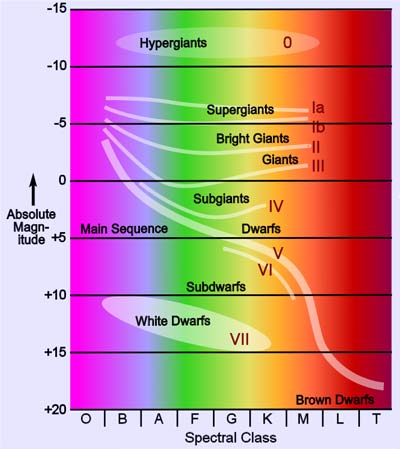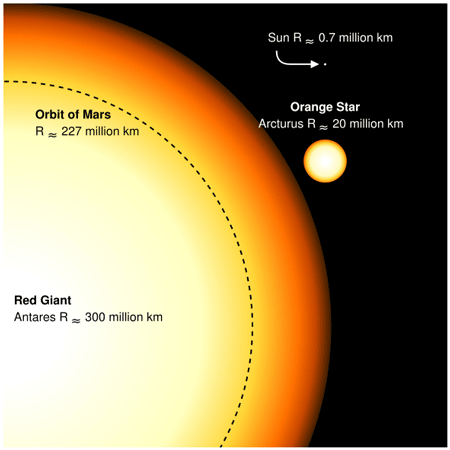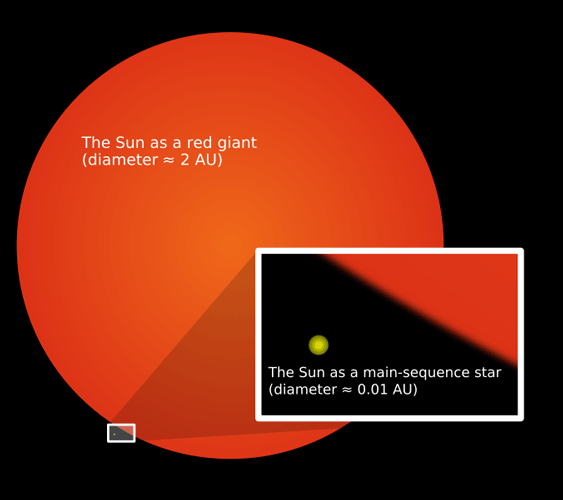A red giant is a luminous giant star of low or intermediate mass that is in a late phase of its evolution, with nuclear fusion going on in a shell outside the core but not in the core itself. The core matter is electron degenerate and extremely compressed, so the outer atmosphere is inflated and tenuous, making the radius immense and the surface temperature low, somewhere from 5,000K and lower. The appearance of the red giant is from yellow orange to red, including the spectral types K and M, but also class S stars and most carbon stars.

Hertzsprung-Russell diagram (*) |
The most common red giants are the so-called Red Giant Branch stars (RGB stars) whose shells are still fusing hydrogen, while the core is inactive helium. Another case of red giants of interest are the Asymptotic Giant Branch stars (AGB) that produces carbon by the triple-alpha process from helium. To the AGB stars belong the carbon stars of type C-N and late C-R.
Prominent bright red giants in the night sky include Aldebaran (Alpha Tauri), Gamma Crucis and Alpha Vulpeculae (Lucida Anseris).
Overview

Comparison between red giants and the Sun
Red giants evolve from main sequence stars with masses in the range from about 0.5 solar masses to somewhere between 4 and 6 solar masses [1].
Red giants are stars with radii hundreds of times larger than that of the Sun which have exhausted the supply of hydrogen in their cores and switched to fusing hydrogen in a shell outside the core. Since the inert helium core has no source of energy of its own, it contracts and heats up, and its gravity compresses the hydrogen in the layer immediately above it, thus causing it to fuse faster. This in turn causes the star to become more luminous (from 1,000 to 10,000 times brighter) and expand; the degree of expansion outstrips the increase in luminosity, thus causing the effective temperature to decrease. In stars massive enough to ignite helium fusion, an analogous process occurs when central helium is exhausted and the star switches to fusing helium in a shell, although with the additional complication that in many cases hydrogen fusion will continue in a shell at lesser depth — this puts stars onto the asymptotic giant branch.[2][3] The decrease in surface temperature shifts the star's visible light output towards the red — hence red giant, even though the color usually is orange. Main sequence stars of spectral types A through K are believed to become red giants. [4]
Very low mass stars are thought to be fully convective[5] and thus may not accumulate an inert core of helium, and thus may exhaust all of their fuel without ever becoming red giants. [6] Such stars are commonly referred to as red dwarfs.
Very high mass stars instead develop to supergiant stars that wander back and forth horizontally over the HR diagram, at the right end constituting red supergiants. These usually end their life as type II supernovae.
If the star is heavier than 0.4 but less than 2.57 solar masses, the addition of helium to the core by shell hydrogen fusing will cause a helium flash — a rapid burst of helium fusing in the core, after which the star will commence a brief period of helium fusing before beginning another ascent of the red giant branch. Stars more massive than 2.5 solar masses, but less than about 4 to 6, enter the helium fusing phase of their lives much more smoothly. The core helium fusing phase of a star's life is called the horizontal branch in metal-poor stars, so named because these stars lie on a nearly horizontal line in the Hertzsprung-Russell diagram of many star clusters. Metal-rich helium-fusing stars do not lie on a horizontal branch, but instead lie in a clump (the red clump) in the Hertzsprung-Russell diagram.[7]
Actually, such stars are not big red spheres with sharp limbs (when one is close to it) as displayed on many images. Due to the very low density such stars may not have a sharp photosphere but a star body which gradually transfers into a 'corona'.
The Sun as a red giant

When the Sun has exhausted its supply of hydrogen to fuse it will swell into the Red Giant phase. The size of the current Sun (now in the main sequence) is here compared to its estimated size during its red giant phase. (*)
The Sun is expected to become a red giant in about 4.57 billion years.[8] It is calculated that the Sun will become almost sufficiently large to engulf the current orbits of some of the solar system's inner planets, including Earth.[9][10][11] However, the gravitational pull of the Sun will have weakened by then due to its loss of mass, and all planets but Mercury will escape to a wider orbit[12]. That said, Earth's biosphere may be destroyed as the Sun gets brighter while its hydrogen supply becomes depleted. The extra solar energy will cause the oceans to evaporate to space, causing Earth's atmosphere to become temporarily similar to that of Venus, before its atmosphere also gets driven off into space.[13] If this happens, Venus and Earth will become burnt out planets; their atmospheres having long been driven off, and their rock will melt.[14]
See also
* Red clump
* Horizontal branch
* Stellar evolution
* Blue giant
* Red dwarf star
* Supergiant
* Red supergiant
* White dwarf
References
1. ^ (1988) The Cambridge Atlas of Astronomy, 2, Cambridge University Press, 255. ISBN 0-521-36360-8.
2. ^ Sackmann, I.-Juliana; Boothroyd, Arnold I.; Kraemer, Kathleen E. (November 1993). "Our Sun. III. Present and Future". Astrophysical Journal 418: 457. The American Astronomical Society.
3. ^ Pogge, Richard W. (2006-01-21). Lecture 16: The Evolution of Low-Mass Stars. Astronomy 162: Introduction to Stars, Galaxies, & the Universe. Retrieved on 2006-12-29.
4. ^ Color of star ranging blue through orange
5. ^ Main-Sequence Stars. Stars. The Astrophysics Spectator (2005-02-16). Retrieved on 2006-12-29.
6. ^ Richmond, Michael. Late stages of evolution for low-mass stars. Retrieved on 2006-12-29.
7. ^ Harvard University search for orange-yellow clumps
8. ^ Our Sun. III. Present and Future,by Sackmann, I.-J., Boothroyd, A. I., & Kraemer, K. E., Astrophysical Journal v.418, p.457
9. ^ Red Giants. HyperPhysics (hosted by the Department of Physics and Astronomy of Georgia State University). Retrieved on 2006-12-29.
10. ^ Strobel, Nick (2004-06-02). Stages 5-7. Lives and Deaths of Stars. Retrieved on 2006-12-29.
11. ^ The fading: red giants and white dwarfs. Retrieved on 2006-12-29.
12. ^ http://www.astronomy.ohio-state.edu/~pogge/Lectures/vistas97.html
13. ^ Pogge, Richard W. (1997-06-13). The Once and Future Sun. New Vistas in Astronomy. Retrieved on 2007-01-23.
14. ^ Date set for desert of Earth (2000-02-21) at Washington
Links
* Measurements of the frequency of starspots on red giant stars
* Sun is a powerhouse - Death in our solar system
Retrieved from "http://en.wikipedia.org/"
All text is available under the terms of the GNU Free Documentation License

